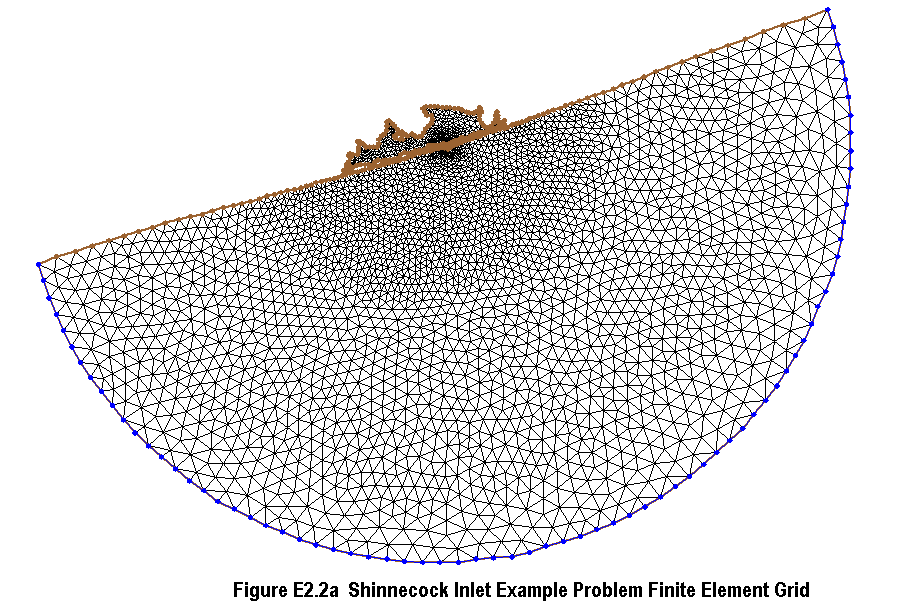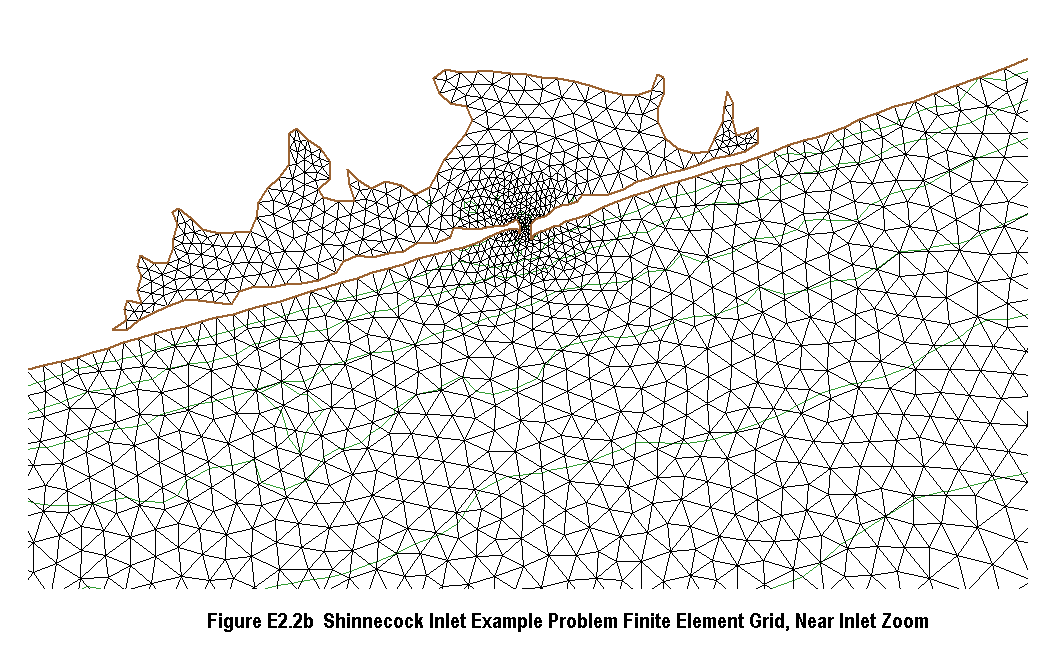- Community
- Documentation
- User’s Manuals, Compile Options, FAQs, Wiki
- Example Problems
- Reports and Publications
- Related software
- News
- 2020 Users Group Meeting Presentations
- 2019 ADCIRC Users Group Meeting
- 2019 Texas ADCIRC Week
- 2018 ADCIRC Week
- 2017 ADCIRC User Group Meeting and ADCIRC Boot Camp
- 2016 ADCIRC User’s Group Meeting and ADCIRC Boot Camp
- 2015 ADCIRC User’s Group Meeting and ADCIRC Boot Camp
- 2014 ADCIRC Workshop and Bootcamp
- ADCIRC Workshop 2013 Final Agenda
- 2011 ADCIRC Workshop Press Release
- 2010 ADCIRC Workshop Abstracts
- 2008 ADCIRC Workshop
- Hurricane Storm Surge Forecasts
- Example Hurricane Katrina Simulation
- Products
- ASGS
ADCIRC
The Official ADCIRC Web Site
Home » » Documentation » Example Problems » Shinnecock Inlet, NY with Tidal Forcing Example
Shinnecock Inlet, NY with Tidal Forcing Example
This example problem was developed as part of study of tidal hydrodynamics in the vicinity of Shinnecock Inlet, NY, at the U.S. Army Corps of Engineers Coastal Hydraulics Laboratory (Williams et al., 1998; Morang, 1999; Miliello et al., 2000).
PROBLEM SETUP: Shinnecock Inlet is a barrier island inlet located along the outer shore of Long Island , NY, Fig. E2.1. The finite element grid used in this example problem is shown in Fig. E2.2a,b. The discretization varies from ~2 km offshore to ~75 m in near shore areas, but remains too coarse to accurately resolve the circulation in the immediate vicinity of the inlet and the back bay, particularly since several strategic areas are obstructed by wetting and drying elements. In addition, several of the elements are poorly shaped near the inlet. Therefore this example should be used only as a guide for input/out file structure and not as a guide for grid building.
ADCIRC INPUT: Two input files are required by ADCIRC to run this test problem. Their format and contents are described in detail in the input file section of the user’s manual. A very brief summary follows. The Grid and Boundary Information File (fort.14) indicates that the grid contains 5780 elements and 3070 nodes. This information is followed by tables of nodal information (node number, horizontal coordinates and depth) and elemental information (element number, number of nodes in an element and node numbers that comprise the element). An elevation specified (open) boundary (1 segment that contains 75 nodes beginning with node number 75 and ending with node number 1) and a normal flow (zero normal flow) mainland boundary (1 segment that contains 285 nodes beginning with node 1 and ending with node 75) complete the file. The Model Parameter and Periodic Boundary Condition File (fort.15) indicates that the model is started from a state of rest (cold started), a longitude, latitude coordinate system is specified, finite amplitude (with elemental wetting and drying), advection and hybrid bottom friction nonlinearities are included, wind stress forcing is not active, and gravity is in units of m/s2 (required using a lat., lon. coordinate system and indicating distance units of m and velocity units of m/s). The model is forced using the tidal potential terms and along the elevation boundary using 5 tidal constituents (M2, S2, N2, O1, K1). This forcing is ramped up over the first two days of the run. The run lasts for 5 days using a time step of 6 s. Water level and velocity time series are output every 300 time steps (1/2 hr) at all nodes in the domain from days 3.8 – 5. No harmonic output or hot start files are generated during the course of the simulation.
ADCIRC OUTPUT: This example run will generate 4 files containing various forms of output information. Their format and contents are described in detail in the output file section of the user’s manual. A very brief summary follows. The General Diagnostic Output file (fort.16) echo prints much of the information from the input files, provides information on processing of input data by ADCIRC and records error messages from ADCIRC. The Iterative Solver ITPACKV 2D Diagnostic Output file (fort.33) contains diagnostic information from the solver if it has difficulty converging. Normally, this file is empty on completion of a model run. The Elevation Time Series at All Nodes in the Model Grid file (fort.63) contains elevation time series output every 300 time steps at all nodes in the domain. The Depth-averaged Velocity Time Series at All Nodes in the Model Grid file (fort.64) contains velocity time series output every 300 time steps at all nodes in the domain. Finally, limited run time information is printed on the screen during model execution.
References
Militello, A., and Kraus, N. C. 2000. Shinnecock Inlet, New York, Site Investigation, Report 4, Evaluation of Flood and Ebb Shoal Sediment Source Alternatives for the West of Shinnecock Interim Project, New York. Technical Report CHL-98-32. U. S. Army Engineer Research and Development Center, Vicksburg, Mississippi.
Morang, A. 1999. Shinnecock Inlet, New York, Site Investigation Report 1, Morphology and Historical Behavior, Technical Report CHL-98-32, US Army Engineer Waterways Experiment Station, Vicksburg, Mississippi.
Williams, G. L., Morang, A., Lillycrop, L. 1998. Shinnecock Inlet, New York, Site Investigation Report 2, Evaluation of Sand Bypass Options, Technical Report CHL-98-32, US Army Engineer Waterways Experiment Station, Vicksburg, Mississippi.


